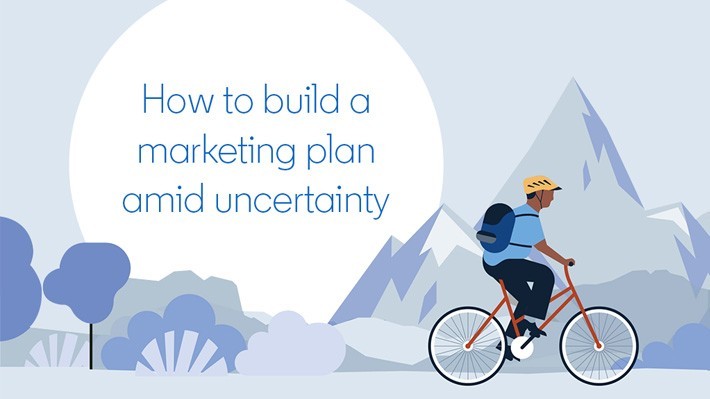How to build a marketing plan amid uncertainty
Marketing runs on plans. One of the most disorientating aspects of 2020 is that our plans have had to change – but without clear, confirmed, new strategies to replace them. Forecasting even six months ahead is fraught with risk. Our planning horizons are shrinking and the plans that we do make come with far more uncertainty.
As a marketing manager, your role involves helping the marketers in your team to regain their bearings and find ways to focus in these circumstances. “In a time of uncertainty, there can be a lot of information swirling and it can be easy to lose focus,” says LinkedIn’s Group Marketing Manager, Garnor Morentes. “You’ll need to help your team centre on what matters most and give your perspective on what they should prioritise in their own personal planning and roles.”
An important starting point is to accept that the nature of plans will be different. In many cases, they won’t cover the same timeframe as the plans you made before the start of the year. They will include hedges and risk-mitigating what-ifs, where you give yourself the opportunity to pivot and adjust to different scenarios. However, planning that’s conditional and sets targets over a shorter period is better than no planning at all. It provides a crucial sense of direction that helps your team to move forward, allocate time, decide on tactics and guide your discussions with the rest of the business. And although planning can reveal just how many known unknowns are out there, it can also reassure your team by confirming the things that are known – and which won’t change.
As a marketing manager, you may not be able to set strategy for the business as a whole, but you can definitely set a strategy for your marketing team: how you’ll meet internal demands, support sales, measure progress and adjust as the situation moves through different phases. Signalling that you’re ready to take the initiative, and you have a plan you believe in, can play a vital role in keeping your team motivated and engaged.
For The Marketing Manager’s Survival Guide, we interviewed marketing managers from businesses large and small about the challenges of planning in uncertain times – and the tactics that they’ve developed to help colleagues move forward. We also spoke to marketing and management experts about how day-to-day plans and broader marketing strategies can adapt. Here’s what they told us.
Be clear about what doesn’t change
It’s not a given that every aspect of your plan has to change. Your core marketing objectives will often remain, even if you’re now looking to meet them over a longer period. Focusing on the fundamentals helps to guide marketing investments during a disorientating time, by highlighting the returns that you can expect over a longer timeframe.
“Our buying cycles can be up to two years, so we’re used to playing the long game, feeding the pipe and making sure the funnel is broad enough that we don’t lose people along the way,” says Alysha Spencer, Head of Enterprise Acquisition and Upsell Marketing at Telefónica UK Limited. “There’s a finite audience out there, so we’ve got to keep them engaged. Our approach is to try and stay constant, driving messaging through our communication channels as planned. A lot of targets are around awareness, credibility in market, engaged contacts and MQLs. Even if leads aren’t converting as quickly, we still hope they will later, so the targets stay the same.”
B2B Institute Research Fellow Peter Field argues that marketing investments made for the longer term are a surer way of supporting growth and sales when the immediate circumstances are unpredictable. “Because the sales funnel in B2B is generally longer than in B2C, the arguments in favour of supporting long-term growth through brand building during a downturn are likely to be even stronger,” he says. “B2B Brand associations created now are likely to bring the greatest sales benefit during the recovery, when the rewards are biggest.”
Adjust your planning approach for different phases of the situation
Many marketers have taken a different approach to planning at different stages of the pandemic. In the early weeks and months, they invested in taking care of customers and building loyalty, while often throttling back on demand messages or pivoting to offer services for free. They also spent a lot of time in response mode, racing to support suddenly emerging needs for different parts of the business. However, it’s important to transition from this firefighting mindset into a more forward-looking one. That could involve working with sales on plans to support the next quarter’s targets – or settling on the most important objectives for marketing given changes in demand.
“The team is very target driven which makes it tough when solid plans must change,” says Dawn Miley, Director of Performance Marketing at Adobe. “It requires flexibility, agility and creativity. While the first quarter of the pandemic drove us into ‘respond’ mode, I’m now trying to ground the team in the things that we can see are important, to give them a feeling of foundation. With demand for certain products on the rise, we have to adjust our targets and plans accordingly.”
Use data to try and pinpoint the changes that matter
For many marketers, the nature of demand itself is changing. Buyers’ different needs mean that interest in one solution can spike while interest in another collapses. They could find themselves suddenly fishing in very different pools of potential customers – and needing to build awareness quickly as a result. In many cases, they’ll need to embrace different channels and tactics – designing new experiences to replace physical events, and adjusting to the changing media habits of their target audiences.
For Upali Dasgupta, Marketing Director Asia for the digital experience platform Sitecore, one of the most noticeable impacts of the pandemic has been changing patterns of engagement. “At the moment, cold prospects are much harder to engage than people who’ve heard from you or who are already customers,” she says. “So we are going deep not broad – focusing on verticalised narratives and outreach to key accounts.”
Richard Turrell, Head of Marketing at the specialist recruitment business Handle, is focusing on insights that can help to reveal the receptiveness of different audience groups. “The biggest unknown is how your messaging is landing,” he says. “You have your personas, but in this situation, every one of those personas has considerations that weren’t there before. The messaging you usually share may suddenly not land in a positive way. The challenge is trying to identify who is in a position where you can sell to them in a positive way – and who you shouldn’t be approaching.”
Other marketers have had no choice but to shift focus to wholly new sectors as the nature of demand changes. In this case, insights that can help to build share of voice efficiently are invaluable. “The pool is smaller and so it’s more competitive,” says Veronica Valdes, Marketing Manager at the recruitment process outsourcing firm, Resource Solutions. “We’re looking at industries and markets that we might not have been involved with before, and we have to find a smart, effective and targeted way to approach them. We usually have a long sales cycle, but now we’re trying to accelerate that and uncover the people who are still in the market quickly.”
Be aware that the meaning of metrics can change
Marketing managers are still able to track many of the same metrics that they followed before the pandemic. However, with audience behaviours changing, the significance of these numbers can change too. It might be easier to capture MQLs as more people engage with helpful content – but that doesn’t mean those MQLs will flow through to conversions and revenue at the same rate. “We’re tracking very well on organic KPIs,” says Dawn Miley, of the need to put numbers in context. “But we are managing expectations around those as it’s indicative of people having more time on their hands.”
Accepting that the buyer journey now moves at different speeds is often the key to keeping sight of what metrics mean – and avoiding pushing too hard on the wrong KPIs at the wrong time.
“ROI can’t always be measured in immediate dollars,” says Eva Taylor, the Director of Social Strategy, Operations and Corporate Social Responsibility at Hootsuite. “When we made the decision to consciously publish less on social media and pause our paid social campaigns for a better audience experience, we expected to have a drop in clicks, form fills and visits to the blog. However, that doesn’t necessarily represent a negative impact for the business, whereas trying to keep those numbers up might do as it could have harmed our brand reputation and in turn affected our relationships with our audience. We still need returns, but we’re aware that they can happen after the crisis has subsided – and we know there are opportunities to make the numbers up.”
Focus on the factors that you can control
It’s the role of marketers to generate demand – but in the current situation, demand also depends on many factors outside of their control. Many businesses have found that the marketing funnel has changed in shape and velocity: people become
leads faster but don’t then convert at the same rate – often because they don’t have the buying power to do so.
In this situation, it’s important to set meaningful targets by focusing on the factors that you can manage. Set KPIs that relate to how marketing contributes to positive outcomes for the business, even if there are fewer of those outcomes at the moment.
Provide room for pivots
In 2020, any marketing plan has to accept that circumstances can change. Booking campaigns over shorter periods and leaving room for pivots makes sound business sense. Monitoring the performance of marketing is more important than ever – as is marketers’ ability to respond.
“What’s changed is the speed at which you need to show the relationship between marketing actions and revenue delivery, and the speed with which you can,” says Michael Betz, B2B Institute Research Fellow and Partner at McKinsey. “Search volumes for some categories are exploding, while for others they’re collapsing. And conversion rates are in flux. It used to be good enough to monitor these trends and adjust spend levels on a weekly or monthly basis. Now it needs to happen hourly or daily.”
It’s all part of a new rhythm of marketing planning that managers must adjust to. Over the longer term, plans have to allow for changing circumstances. In the short term, they need greater responsiveness built in. It may not be possible to predict exactly what will happen – but it helps your team if you’ve put together a credible plan for how you’ll respond as different scenarios play out.
Would you like more advice and support for managing through uncertain times? You’ll find it in The Marketing Manager’s Survival Guide, which is packed with insights and experiences from businesses large and small. It’s available for free download now.
Related articles



